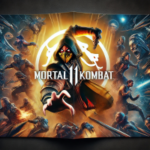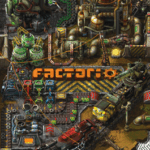Factorio is not just a game—it’s a logistical puzzle, a construction sandbox, and a strategic marvel that has captivated millions of players worldwide. Developed by Wube Software, Factorio challenges players to build and automate vast factory systems on an alien planet, transforming raw resources into advanced technologies through a web of interconnected machines. With its emphasis on optimization, scale, and creativity, Factorio stands as one of the most iconic and influential games in the simulation and automation genre.
What makes Factorio remarkable is its depth and complexity, combined with a surprising level of accessibility. Whether you're a casual builder or a hardcore efficiency optimizer, the game lets you play at your own pace, offering satisfaction through small mechanical victories and large-scale industrial breakthroughs alike. From hand-mining your first piece of iron to launching rockets into space, the journey is both intellectually demanding and endlessly rewarding.
1. The Premise and Starting Point
Factorio begins with a simple setup: your spaceship crashes on an alien planet, and your goal is to build a factory that will allow you to repair your craft and ultimately launch a satellite into orbit. Starting with just a pickaxe and a few blueprints, you’ll mine resources, craft basic tools, and construct rudimentary machines. This small beginning sets the stage for an epic evolution in automation.
The simplicity of the early game allows players to grasp core mechanics—how to mine resources, smelt ore, and produce basic items like gears and circuits. It’s this foundational experience that prepares players for the exponential growth that follows as the factory expands and systems become more complex.
2. Core Gameplay: Building and Automation
At its heart, Factorio is about turning chaos into order. Players build automated production lines that transport resources, assemble components, and manage outputs. Conveyors, inserters, assemblers, and splitters form the backbone of your operation. As the game progresses, new technologies unlock more advanced machinery, modules, and logistic systems.
Every aspect of the game revolves around systems thinking. Players must consider ratios, throughput, and efficiency. A single bottleneck—like a slow inserter or an undersupplied conveyor belt—can cripple an entire production line. This leads to a satisfying loop of building, identifying inefficiencies, and improving design over time.
3. Technology and Research Progression
Factorio features a tech tree that drives progression. Researching new technologies unlocks buildings, materials, and automation upgrades. To perform research, players must produce science packs—colored units that require increasingly complex ingredients and production chains.
This design ties advancement directly to factory growth. You can’t simply unlock new tech by clicking a button; you must build the infrastructure to support it. Higher-tier science packs, like purple or yellow, demand advanced circuits, modules, and rare materials, encouraging players to scale up their operations and refine their logistics.
4. Logistics and Resource Management
Efficient logistics are vital to success in Factorio. Moving resources from point A to B is not trivial. The game offers several methods: belts, underground belts, splitters, trains, and robotic logistics. Each method has advantages depending on scale, speed, and complexity.
For instance, belts are ideal for short-distance transport and offer visual clarity, while trains are perfect for moving large quantities of materials across massive factories or between outposts. Managing fuel supplies, signal timing, and train networks becomes a high-level skill set that transforms players into full-fledged transport engineers.
5. Power Systems and Energy Scaling
Nothing in Factorio works without power. Early factories run on steam engines fueled by coal, but as demands grow, players transition to more efficient solutions like solar panels, accumulators, and nuclear reactors. Each energy source requires a different setup, balancing space, production cost, and reliability.
Nuclear power, for example, provides massive energy output but introduces new layers of complexity like heat management, uranium processing, and reactor cooling. Managing your power grid becomes essential when adding electric mining drills, laser turrets, or mass robotic systems that draw significant wattage.
6. Defending Against Alien Threats
Factorio is not without danger. The planet you’re industrializing is inhabited by native creatures known as biters. As your factory expands and pollution spreads, these creatures become increasingly aggressive, attacking your structures and damaging critical infrastructure.
Defense systems include turrets, walls, and player-operated weapons. Managing pollution, choosing factory locations, and deploying automated defenses all play a role in survival. Later in the game, players can research advanced weapons like flamethrowers, laser turrets, and artillery to secure their factory from growing threats.
7. Multiplayer and Co-op Gameplay
One of Factorio’s most compelling features is its multiplayer mode. Players can build massive collaborative factories or split roles among team members—one focusing on research, another on logistics, and another on power or defenses. The game supports both peer-to-peer and dedicated server setups, ensuring smooth performance even on large maps.
Multiplayer adds a new dimension to planning and coordination. Teams must agree on layouts, manage shared resources, and adapt to each other’s building styles. It’s an ideal setting for streamers, community events, or engineering enthusiasts looking to tackle megaprojects with friends.
8. Modding and Community Content
Factorio boasts a vibrant modding community. From quality-of-life improvements and UI enhancements to complete gameplay overhauls, the mod ecosystem extends the game's replayability indefinitely. Mods like Bob’s Mods, Angel’s Mods, and Space Exploration introduce new technologies, buildings, and challenges that push factory design to new heights.
Mod integration is seamless through the in-game browser and launcher. Players can create custom scenarios, add challenges, or transform the game into a space-based adventure. The developers actively support the modding community with tools and documentation, making Factorio one of the most customizable games available.
9. Optimization and Megabase Building
As players progress, the ultimate challenge becomes efficiency and scale. Megabases—massive factories that produce thousands of items per minute—are a badge of honor in the Factorio community. Achieving this level requires perfect ratios, efficient layouts, and minimized transport congestion.
Optimization techniques include blueprint books, circuit networks, modular base design, and belt balancers. Veteran players often spend hundreds of hours fine-tuning layouts, improving UPS (updates per second), and showcasing factories that span the entire map. Factorio becomes not just a game but a creative and mathematical pursuit of perfection.
10. Longevity, Updates, and Developer Commitment
Factorio officially released in 2020 after years in early access, but Wube Software continues to update and expand the game. The developers are known for their transparent development logs, regular patches, and dedication to player feedback. A paid expansion pack is also in development, promising new content, mechanics, and extended playtime.
The game’s minimalist graphics are optimized for performance, allowing even large factories to run smoothly on most systems. Its intuitive interface and stable performance make it a benchmark for other simulation games aiming for complexity without chaos.
Conclusion: Factorio – A Masterclass in Design, Depth, and Satisfaction
Factorio is a rare masterpiece that blends logic, creativity, and long-term strategy into a deeply satisfying loop of construction and improvement. It challenges the mind without overwhelming the player, offering countless opportunities to learn, adapt, and optimize. Whether you’re laying your first belt line or managing a megabase that spans kilometers, every step feels meaningful and earned.
This is a game that respects your intelligence and rewards your investment. It teaches programming logic without writing code, introduces logistical theory without textbooks, and delivers the joy of problem-solving through interactive design. Factorio is more than a game—it’s a platform for thinking.
Final Overall Rating: 5 out of 5
Factorio is not just one of the best simulation games ever made—it’s a timeless toolset for creativity, logic, and satisfaction. Whether you play solo or with friends, casually or competitively, it will pull you in—and it might never let you go.




























